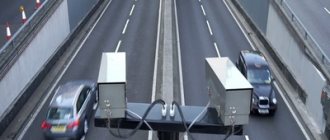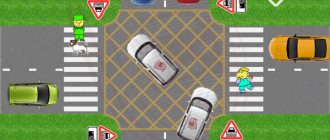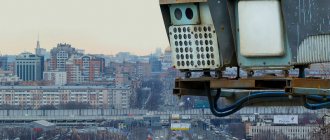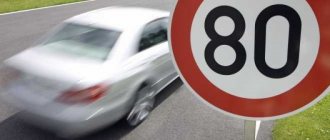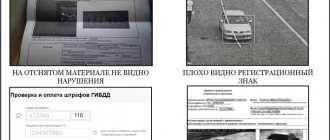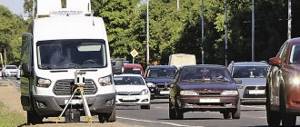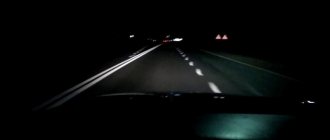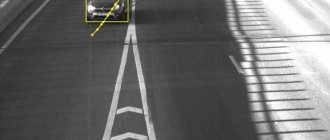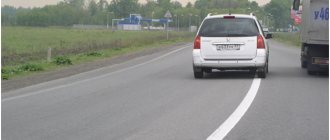Initially, systems for automatically recording traffic violations were planned to be installed in places with high accident rates to “calm down” traffic, but the regions very quickly realized that this method of replenishing the budget was quite effective, so they began to install stationary cameras on the principle “here is where the driver can violate.” Gradually, the systems learn to record more and more violations, disciplining drivers.
It must be remembered that when violations are recorded by automatic cameras, there is a “presumption of guilt”, that is, the driver has to prove his innocence or that the complex is working with errors.
Speed violation
The first cameras were only able to record drivers exceeding the speed limit; they were installed on the borders of populated areas, but today such complexes are installed both within the city and on country roads. The most controversial are the complexes that record the average speed in a certain area. There is no concept of “average speed” in the traffic rules, but the use of Avtodoria, Cordon-Temp and other complexes is recognized as legal, as are fines for them.
According to Art. 12.9 of the Code of Administrative Offenses of Russia, exceeding the permitted speed by 20–40 km/h, recorded by automatic violation detection systems, is punishable by a fine of 500 rubles.
, at 40–60 km/h - in the amount of 1000 rubles, at 60–80 km/h - in the amount of 2500 rubles, if exceeding the permitted speed by more than 80 km/h - a fine of 5000 rubles.
Complexes for recording violations have long been able to “shoot” in the back
Complex complexes for recording violations have long been able to “shoot” in the back
What cameras record citizens who do not comply with traffic rules in the Russian Federation?
Cameras for photo or video recording, which are designed to record violations of traffic rules, are divided into two groups :
- recording traffic violations automatically;
- which traffic police officers use when imposing a traffic fine.
More information about the types of cameras for recording traffic violations can be found here.
With automatic fixation
ATTENTION : These cameras, once configured and installed, do not require user control and will continue to operate without user intervention. Theoretically, they can catch any violation of traffic rules, since according to the law there are no restrictions in this regard. But in practice, these cameras only catch a few types of offenses.
Automatic cameras, in turn, are divided into three subtypes:
- Portable . Every time they are transported, they need to be installed and configured again by traffic police officers, and this happens every day. These cameras only record speeding.
- Stationary ones , unlike portable ones, are installed only once and then independently carry out their work around the clock. They can detect violations in several lanes at once, including oncoming lanes. Stationary cameras are the most advanced and detect a large number of violations, and their list only grows with their development.
- Mobile ones are located in state traffic police cars or public transport and, as they move, they record violations of the drivers of these vehicles.
From traffic police officers
These cameras are only an additional tool for traffic police officers and do not independently record any violations. A fine from such cameras can only be imposed manually by traffic police officers. And the cameras can be as follows:
- The inspector has a camera . With it, the inspector removes the detected violation, and then stops the car with the violator. Or the information along with the recording is transmitted to the next post, where the driver will be stopped and a fine will be issued to him;
- A stationary camera located in front of the traffic police post . This camera is automatic, but can only record the license plate number of a passing car, which greatly facilitates the work of traffic police officers. And violations and fines are imposed only by the employees themselves.
Watch a video about the operation of cameras recording traffic violations:
Entering a dedicated lane for public transport
The pioneer here was Moscow, whose authorities decided to give priority to public transport, allocating separate lanes for it. Later, other cities began to join the capital. Moreover, the days on which you can go to the dedicated lanes (in Moscow these are Saturday and Sunday), as well as the list of vehicles that are allowed, as well as buses and minibuses, to move along these lanes (in Moscow, taxis are equated to public transport), regional the authorities decide for themselves.
For some time, the Moscow authorities installed cameras on public transport, but then abandoned this idea
For some time, the Moscow authorities installed cameras on public transport, but then abandoned this idea
In Moscow and St. Petersburg, a fine of 3,000 rubles is provided for entering the public transport lane in violation of traffic regulations.
, throughout the rest of Russia - 1500 rubles. (Article 12.17 of the Administrative Code). There is a 50% discount. By the way, many cameras that record access to a dedicated area can also result in a fine for the next violation.
How traffic police cameras make mistakes
One can only rejoice at the tightening of supervision on the roads. However, many motorists are not at all happy, as they received fines for absolutely correct maneuvers, forced stops for repairs, and even for shadows from motorcycles. The reason for this injustice lies in the imperfection of traffic camera software.
Fine for avoiding an accident
As mentioned above, it is now difficult to find a street without a traffic police surveillance device. Therefore, by avoiding an accident in oncoming traffic, you are committing a traffic violation, for which a monetary penalty is provided.
Motorcyclist fined for being a silhouette on the lane
When driving, the shadow of a motorcyclist may fall onto the oncoming lane. The camera recognizes this as a violation. If the TsAFAP (traffic police) operator does not notice the error, a report will be issued to the driver.
Penalty for changing a wheel
If you pull over to the side of the road to replace a broken tire within the coverage area of sign 3.27, the camera will most likely record a violation. If the operator does not see you with the wheel, a report will be issued.
Even absurd fines can only be canceled by filing a complaint. The law provides for 10 days for this procedure. .
The location of traffic police cameras on the online map 2021 will help you plan a route and follow it according to the traffic rules. After all, modern recording devices record not only speeding, but also a number of other traffic violations.
Violation of markings (crossing a solid line)
Initially, such complexes were supposed to wean those who like to turn and leave the roads in the second (and sometimes third and fourth) row. In addition to exits and turns, such complexes began to be installed in tunnels and at the entrance to them.
The resolution will include photographs, and the camera will trace the trajectory of the car before recording a traffic violation.
The resolution will include photographs, and the camera will trace the trajectory of the car before recording a traffic violation.
The fine is issued in accordance with part one of Art. 12.16 Code of Administrative Offenses of Russia, it is 500 rubles.
, and there is a 50 percent discount.
Entering a busy intersection
Most serious traffic congestion in major cities occurs because drivers, trying to quickly cross an intersection, actually block it. They do not have time to pass the permitting signal, then the cars begin to move in a perpendicular direction, as a result, traffic stops in all directions.
At first, as an experiment, drivers who entered a busy intersection were fined in a couple of places in Moscow. And this year the concept of “waffle markings” was introduced into the traffic rules. It is enough to be inside it after the prohibitory traffic light comes on, and the camera will immediately record the violation.
Waffle markings at intersections appeared in traffic regulations this year and immediately began to be implemented en masse in large cities
Waffle markings at intersections appeared in traffic regulations this year and immediately began to be implemented en masse in large cities
The fine will come for violating clause 13.2 of the Russian Traffic Regulations. Most likely, he will be discharged under Part 1 of Article 12.13 of the Code of Administrative Offenses of Russia. It is 1000 rubles.
But theoretically, a fine can also be issued for violating marking regulations (part one of Article 12.16 of the Code of Administrative Offenses of the Russian Federation). It is 500 rubles. In both cases there is a 50% discount.
When will they start recording?
This is not yet known. The fact is that the material and technical base for the possibility of issuing orders for driving without insurance is already practically working; in fact, not a single camera on the roads checks the presence of a compulsory motor liability insurance agreement.
To understand that there is currently no answer to this question, let's trace the chronology of events and find out how many times the launch was planned but postponed.
- The very first news about the start of video recording for driving without compulsory motor insurance appeared at the end of 2015 - then it was still an initiative with the task of working out the technical part.
- In 2021, “fake news” began to circulate on the Internet in the form of the latest news that cameras began to fine drivers for not having compulsory motor insurance. This turned out to be untrue.
- The same publications circulated on the Internet until 2021 - with a clearly visible change in the beginning of the recording of driving without insurance, and then information that verification of the availability of the policy was postponed.
- Meanwhile, at the same time, the Russian Union of Auto Insurers (RUA) began to assert that the database with vehicle registration numbers is ready to determine the absence of compulsory motor liability insurance. But the traffic police were not ready yet.
- Not long ago, the RSA again threatened to soon begin recording this violation with cameras.
- But one day such auto-fixing was launched in test mode - only the car owners did not receive fines, but simply notifications about the lack of insurance. Thus, the system was tested and insured against the consequences of errors, in fact, by the absence of such consequences, because no punishments were imposed.
- As of May 20, 2021, the system is still being prepared for launch, and it is planned that this will happen in Moscow.
Violations at pedestrian crossings
Due to the high mortality rate of pedestrians, the fine for not allowing a pedestrian to pass in Russia was increased: today it ranges from 1,500 to 2,500 rubles. (Article 12.18 of the Code of Administrative Offenses of the Russian Federation). The cameras issue fines of 2,500 rubles.
If the inspector almost always interprets the situation in favor of the pedestrian, then the automatic complex begins to “guide” the pedestrian as soon as he steps onto the crossing. At the same time, vehicles are recorded. If the trajectories of the pedestrian and vehicles do not intersect, then there will be no fine.
What is not removed?
Photographic recording of traffic rules violations is not always possible. The cameras are not yet able to record other violations. Of course, progress does not stand still, and soon cameras may be able to completely replace patrol services.
There are also restrictions regarding recorded violations . For example, a violation for speeding will not be recorded by cameras unless the speed exceeds 20 km/h. This is due to economic considerations, for example, a fine for exceeding the speed limit by ten kilometers per hour will be only one hundred rubles, and the execution and delivery of the resolution by registered mail will cost the state more.
TIP : Also a slippery point is the recording of driving without a seat belt fastened - particularly cunning drivers who vehemently do not want to wear a seat belt can fool the cameras by wearing a T-shirt with a black diagonal stripe.
Crossing the stop line
This year they began to introduce systems that record the passage of stop lines. At intersections, it is enough to cross it with two front wheels, and the complex will record a violation, after which the car owner will receive a fine under Part 2 of Art. 12.12 Code of Administrative Offenses of Russia - 800 rubles.
There is a 50% discount. If the corresponding sign is installed in front of the line, the fine will be 500 rubles, a 50 percent discount also applies (Part 1 of Article 12.16 of the Administrative Code).
When driving through a stop line with a corresponding sign without stopping, the camera “guides” the vehicle, recording its speed
When driving through a stop line with a corresponding sign without stopping, the camera “guides” the vehicle, recording its speed
Are cameras fined for compulsory motor liability insurance today?
No. As of May 20, 2021, not a single driver or car owner in Russia has received a fine for not having MTPL insurance. And, if you see anywhere information that someone has received a “chain letter” - a fine for this, then this is nothing more than a fake.
Please note that there is supposedly a photo floating around the Internet showing a resolution with a fine for driving without a policy in the amount of supposedly 500 rubles. It is not true. At least, because there is no such sanction specifically for the lack of compulsory motor liability insurance - the punishment is provided for in Article 12.37, part 2, and the traffic police fine is 800 rubles.
“Ducks” about the beginning of fixation were also periodically denied by the traffic police.
Driving through a prohibitory traffic light
Cameras began recording this violation relatively recently. Moreover, driving beyond the stop line is also considered passing. Article 12.12 of the Code of Administrative Offenses provides for a fine of 1,000 rubles for this violation.
, and for a repeat - 5,000 rubles. It is worth remembering that a yellow traffic light is also prohibitive. In addition, some complexes also detect turning to a prohibitory signal (when the additional section of the traffic light is extinguished).
Recently, cameras have begun to appear at railway crossings that also record passage through a prohibitory signal (even if the barrier is raised, you must wait until the red lights go out). The fine here is the same - 1000 rubles. and 5000 rub. upon repeated violation.
